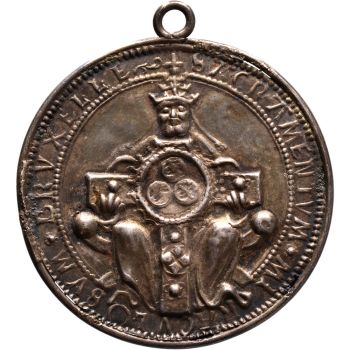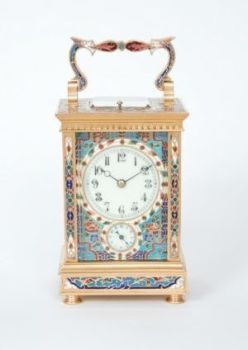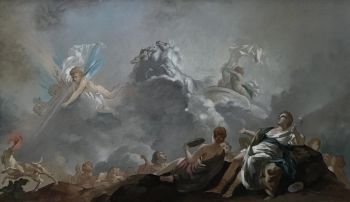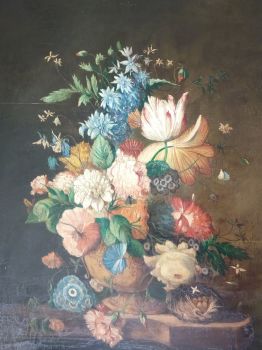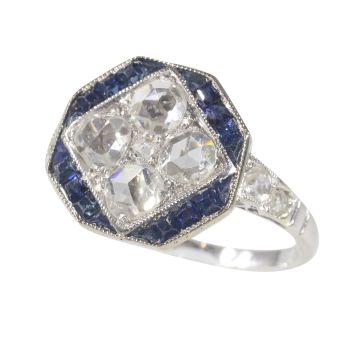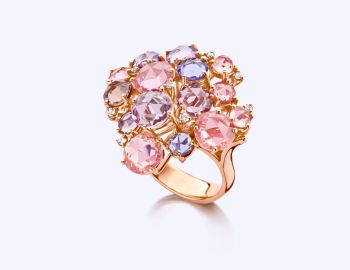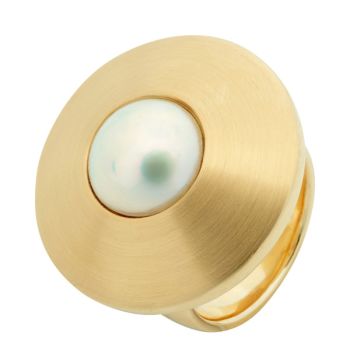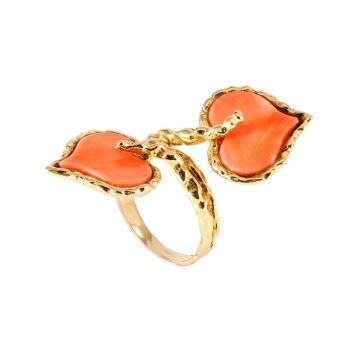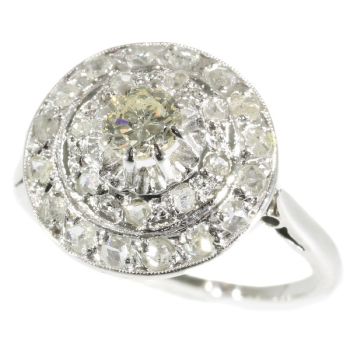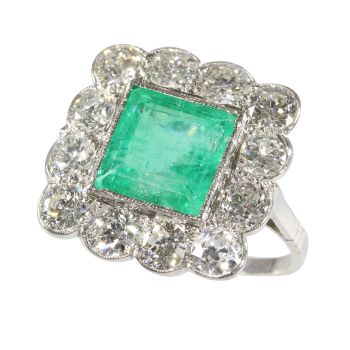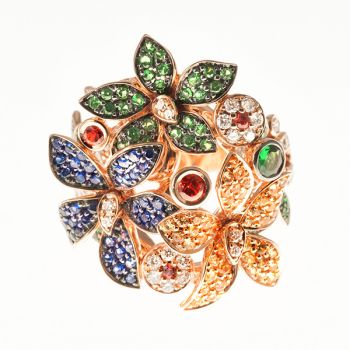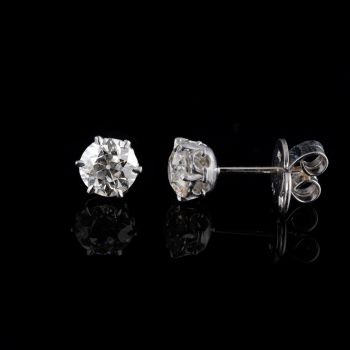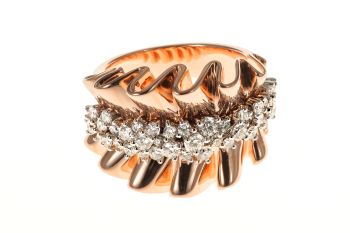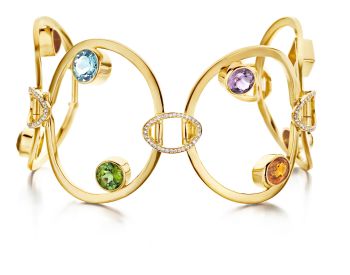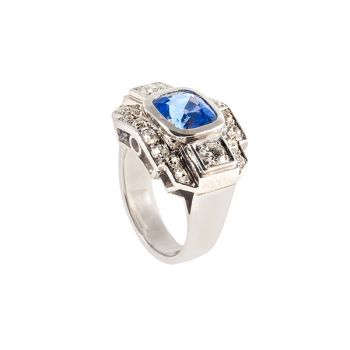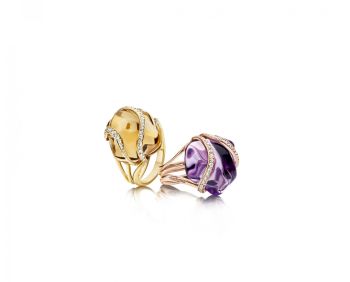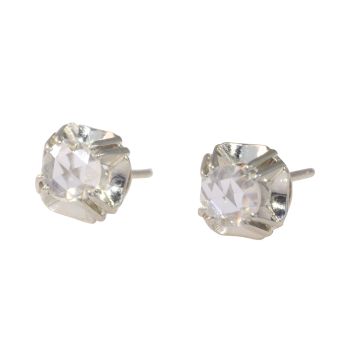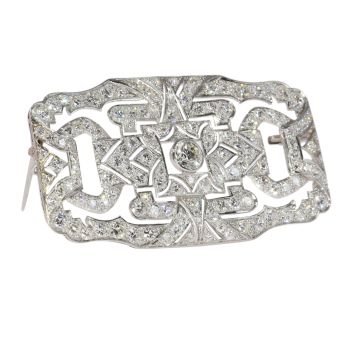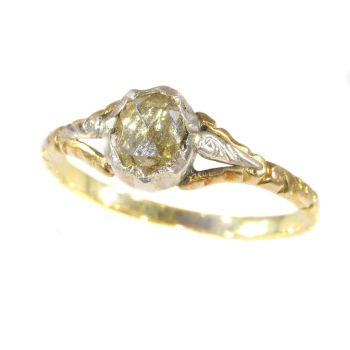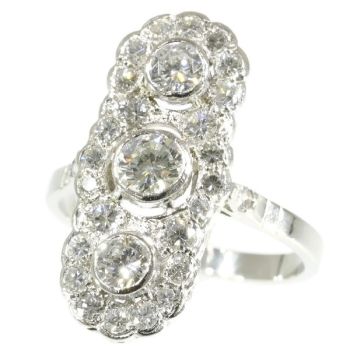Historical Baroque Diamond Ring from the 1680s 1680
Onbekende Kunstenaar
Adin Fine Antique Jewellery
- Over kunstwerk
This vintage antique ring from the 1680s exemplifies Baroque artistry with its dynamic movement and overt emotion. Crafted in warm yellow gold and silver, the ring features seven table cut rose cut diamonds set on foil to enhance their lustre. The topsection of the ring dates back to between 1650 and 1700, while the shank was replaced around 1840, evidenced by the horse head hallmark. This piece, with its rich history and intricate craftsmanship, is likely from France or Belgium. The combination ofBaroque style and the meticulous setting technique makes this ring a timeless treasure.
Antique jewelry object group
ring
Condition
very good condition
more info on our condition scale
Country of origin
France or Belgium (see explanation on hallmarks further in text)
Style
Baroque - Baroque is an artistic style prevalent from the late 16th century to the early 18th century in Europe. It is most often defined as "the dominant style of art in Europe between the Mannerist and Rococo eras, a style characterized by dynamicmovement, overt emotion and self-confident rhetoric".
See also: Baroque
more info on styles
Period
ca. 1680
Events & facts of this era, poetry of this era, fashion of this era.
Material 18K
warm yellow gold and silver (touchstone tested)
more info on precious metals
Technique
The rose cuts are set on foil. This is a special technique that was used to bring the lustre of the diamonds to its best quality.
Extra information
The main part of the ring (the top section) was crafted sometime between 1650 and 1700, as indicated by the diamond's cut. However, the shank was replaced around 1840, as evidenced by the horse head hallmark. Traces of this work can still be seen on theinside of the ring.
Diamonds
Seven table cut rose cut diamonds. We do not have the weight of the diamonds which is normal in our trade when it comes to rose cuts.
All diamonds we offer are screened by the I.J.G.C. for whether they are natural or synthetic, and all diamonds in this jewel are 100% guaranteed to be natural.
Birthstones
Diamond is the birthstone (or month stone) for April.
more info on birthstones
Hallmarks
The control mark here represents a horse’s head and was in use in Belgium from 1831 and in France from about 1838.
more info on hallmarks
Dimensions
band width top of ring 0,69 cm (0,27 inch)
see picture with a ruler in millimeters and inches
Weight
2,70 gram (1,74 dwt)
Ring size Continental EU: 58 & 18½ , Size USA: 8¼ , Size UK: Q
Resizing
Free resizing (only for extreme resizing we have to charge).
more info on ring sizes
Adin Reference Nº
24161-0031
Copyright photography
Adin, fine antique jewellery
Additional information
our latest acquisitions
jewelry glossary
wall of fame
visit us in Antwerp
subscribe to our mailinglist
- Over kunstenaar
Het kan voorkomen dat een kunstenaar of maker onbekend is.
Voor sommige werken is het niet te bepalen door wie het gemaakt is of dat het is gemaakt door (een groep) ambachtslieden. Voorbeelden zijn beelden uit de Oudheid, meubels, spiegels of handtekeningen die vaak niet duidelijk of leesbaar zijn. Maar ook sommige werken zijn helemaal niet gesigneerd.
Ook kunt u de volgende beschrijving vinden:
•"Toegeschreven aan …." waarschijnlijk een werk van de kunstenaar maar niet zeker of gedeeltelijk
•“Atelier van ….” of werkplaats van” een werk uitgevoerd in het atelier of atelier van de kunstenaar, eventueel onder zijn toezicht
•“Cirkel van ….” een werk uit de periode van de kunstenaar die zijn invloed laat zien, nauw verbonden met de kunstenaar maar niet noodzakelijkerwijs zijn leerling
•“Stijl van ….” of “Volger van ….” een werk uitgevoerd in de stijl van de kunstenaar, maar niet noodzakelijk door een leerling; kan eigentijds of bijna eigentijds zijn
•“Wijze van ….” een werk in de stijl van de kunstenaar maar van latere datum
•"Na …." een kopie (van welke datum dan ook) van een werk van de kunstenaar
•“Getekend…”, “Gedateerd….” of “Ingeschreven” dan is het werk gesigneerd/ gedateerd/ ingeschreven door de kunstenaar. De toevoeging van een vraagteken duidt op een element van twijfel
•"Met handtekening ...", "Met datum ...", "Met opschrift..." of “Draagt signatuur/datum/opschrift” dan is de handtekening/datum/opschrift toegevoegd door iemand anders dan de kunstenaar
Bent u geïnteresseerd om dit kunstwerk te kopen?
Artwork details
Related artworks
- 1 - 4 / 12
Johannes van Dreght
Antique Dutch still life flowers in vase1740 - 1800
Prijs op aanvraagGallerease Selected
Peter Paul Rubens (circle of)
Portrait of a man disguised as an oriental1620 - 1630
Prijs op aanvraagGallerease Selected
Onbekende Kunstenaar
Een Gotische zuidelijke Nederlanden wandklok1580 - 1590
Prijs op aanvraagNico van den Assem restauratie
1 - 4 / 24- 1 - 4 / 24
Ans Hemke-Kuilboer
Solitair diamanten oorstekers2000 - 2017
Prijs op aanvraagAns Hemke-Kuilboer Juwelier & Antiquair
Onbekende Kunstenaar
Retro ring in platina bezet met diamanten en een saffier1940 - 1950
Prijs op aanvraagLyppens Juweliers
1 - 4 / 24- 1 - 4 / 12


















